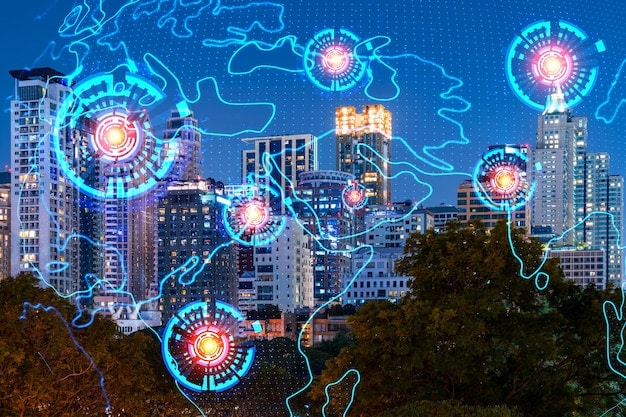The Future of Cybersecurity: AI-Powered Threat Detection and Prevention

The future of cybersecurity is being shaped by AI-powered threat detection and prevention systems, offering faster, more accurate, and proactive defenses against increasingly sophisticated cyberattacks.
The digital landscape is constantly evolving, and so are the threats lurking within it. The emergence of AI is revolutionizing how we approach security, offering sophisticated tools to detect and prevent cyberattacks. The future of cybersecurity: AI-powered threat detection and prevention will be indispensable for business as it grows.
The Rise of AI in Cybersecurity
Artificial intelligence is no longer a futuristic concept; it’s a present-day reality transforming industries across the board, particularly in cybersecurity. Its ability to process vast amounts of data and identify patterns that humans might miss makes it an invaluable asset in the fight against cyber threats.
Understanding AI’s Potential
AI’s role in cybersecurity is multifaceted, ranging from automating routine tasks to providing advanced threat intelligence. The key is leveraging AI’s strengths to augment existing security measures, creating a more robust and resilient defense system.
Benefits of AI-Driven Security
- Enhanced Threat Detection: AI algorithms can analyze network traffic, system logs, and user behavior to identify anomalies that indicate a potential attack.
- Automated Response: AI can automate incident response, quickly isolating infected systems and preventing the spread of malware.
- Predictive Analysis: By analyzing historical data, AI can predict future attacks and proactively implement security measures to mitigate risks.
- Improved Efficiency: AI can automate repetitive tasks, freeing up human analysts to focus on more complex security challenges.

In essence, AI offers a proactive approach to cybersecurity, shifting from reactive defense to predictive prevention.
AI-Powered Threat Detection: A New Era of Vigilance
Traditional threat detection methods often struggle to keep pace with the evolving threat landscape. AI-powered threat detection offers a more dynamic and responsive solution, capable of adapting to new and emerging threats in real-time.
How AI Detects Threats
AI algorithms use machine learning techniques to analyze data and identify patterns associated with malicious activity. This can include detecting unusual network traffic, identifying suspicious files, and flagging anomalous user behavior.
Key Components of AI Threat Detection
- Machine Learning: Algorithms learn from data to identify patterns and predict future threats.
- Behavioral Analysis: AI monitors user and system behavior to detect anomalies that may indicate an attack.
- Anomaly Detection: AI identifies deviations from normal activity, flagging potential security incidents.
- Real-Time Analysis: AI processes data in real-time, enabling immediate detection and response to threats.
By leveraging these components, AI-powered threat detection systems can provide a comprehensive and proactive approach to security.
AI-Driven Threat Prevention: Proactive Defense Strategies
While threat detection is crucial, prevention is even more desirable. AI-driven threat prevention aims to stop attacks before they can cause damage, leveraging AI’s predictive capabilities to identify and neutralize threats proactively.
Early Intervention with AI
AI can analyze threat intelligence data and identify potential vulnerabilities in systems and applications. This allows security teams to patch vulnerabilities and implement security measures before attackers can exploit them.
Techniques for AI-Driven Prevention
There are several key techniques used in AI-driven threat prevention:
- Vulnerability Assessment: AI scans systems for known vulnerabilities and recommends remediation steps.
- Predictive Threat Intelligence: AI analyzes threat data to predict future attacks and implement preventative measures.
- Adaptive Security Measures: AI dynamically adjusts security policies based on real-time threat analysis.
This proactive approach to security can significantly reduce the risk of successful cyberattacks.
Challenges and Limitations of AI in Cybersecurity
Despite its immense potential, AI in cybersecurity is not without its challenges. Overcoming these limitations is crucial for realizing the full benefits of AI-powered security.
Addressing AI’s Vulnerabilities
One of the main challenges is the potential for attackers to use AI to evade detection. Adversarial attacks, where attackers craft malicious inputs that fool AI systems, are a growing concern.
Limitations of AI Include:
- Data Dependency: AI algorithms require large amounts of high-quality data to perform effectively.
- Adversarial Attacks: Attackers can manipulate data to fool AI systems.
- Explainability: Understanding why an AI system made a particular decision can be difficult.
Addressing these challenges requires ongoing research and development, as well as a focus on building robust and resilient AI systems.
The Future of AI in Cybersecurity
The future of AI in cybersecurity is promising, with ongoing advancements in AI technology paving the way for even more sophisticated security solutions. The integration of AI with other emerging technologies, such as blockchain and quantum computing, holds particular potential.

Evolving AI Capabilities
We can expect to see AI systems that are more autonomous, more adaptive, and more capable of handling complex security challenges. These systems will be able to learn from experience, adapt to changing threat landscapes, and make decisions in real-time without human intervention.
Future Integration of AI with:
- Blockchain: Enhancing data security and integrity.
- Quantum Computing: Developing more powerful encryption algorithms.
- IoT Security: Protecting the growing number of connected devices.
The future of cybersecurity will be heavily influenced by AI, offering more effective and efficient means of protecting our digital assets.
Preparing for an AI-Powered Cybersecurity Landscape
As AI becomes increasingly integrated into cybersecurity, it’s essential for organizations to prepare for this new landscape. This includes investing in AI-powered security solutions, training employees on AI security best practices, and developing a comprehensive AI security strategy.
Creating Your AI Security Strategy
Developing an AI security strategy involves not only choosing the right technologies but also fostering a culture of security awareness throughout the organization. Employees should be trained on how to identify and respond to AI-related threats.
Steps for Preparation
- Invest in AI Security Solutions: Implement AI-powered threat detection and prevention systems.
- Train Employees: Educate employees on AI security best practices.
- Develop a Strategy: Create a comprehensive AI security strategy.
By taking these steps, organizations can better protect themselves from the ever-evolving cyber threat landscape.
| Key Point | Brief Description |
|---|---|
| 🛡️ AI Threat Detection | Uses machine learning to identify and respond to security threats in real-time. |
| 💡 Predictive Analysis | Analyzes historical data to predict future attacks and proactively mitigate risks. |
| 🤖 Automation | Automates repetitive security tasks, freeing up human analysts for complex issues. |
| 🌐 Blockchain Integration | Enhances data security and integrity in cybersecurity applications. |
Frequently Asked Questions
▼
AI enhances threat detection by analyzing large datasets and identifying patterns that humans might miss, enabling faster and more accurate responses to cyberattacks.
▼
Challenges include the potential for adversarial attacks, data dependency, and the lack of explainability in AI decision-making processes, which can hinder trust.
▼
AI can predict potential vulnerabilities by analyzing threat intelligence data, allowing organizations to implement preventative measures and patch systems before attacks occur.
▼
Machine learning algorithms learn from data to improve threat detection and response, adapting to new threats and enhancing security over time automatically.
▼
Organizations can prepare by investing in AI security solutions, training employees on new security practices, and developing a comprehensive AI security strategy for defense.
Conclusion
The integration of AI into cybersecurity is not merely a trend but a fundamental shift in how we protect our digital assets. By embracing AI-powered threat detection and prevention, organizations can stay ahead of cybercriminals and build a more secure digital future.





